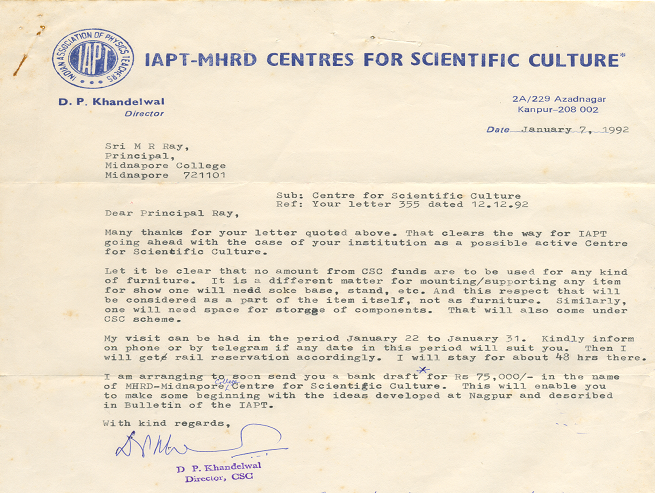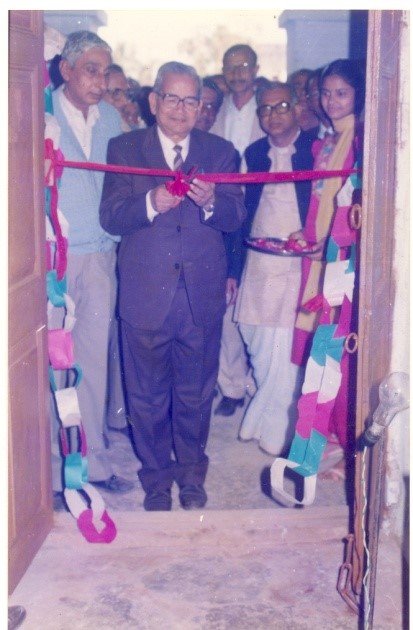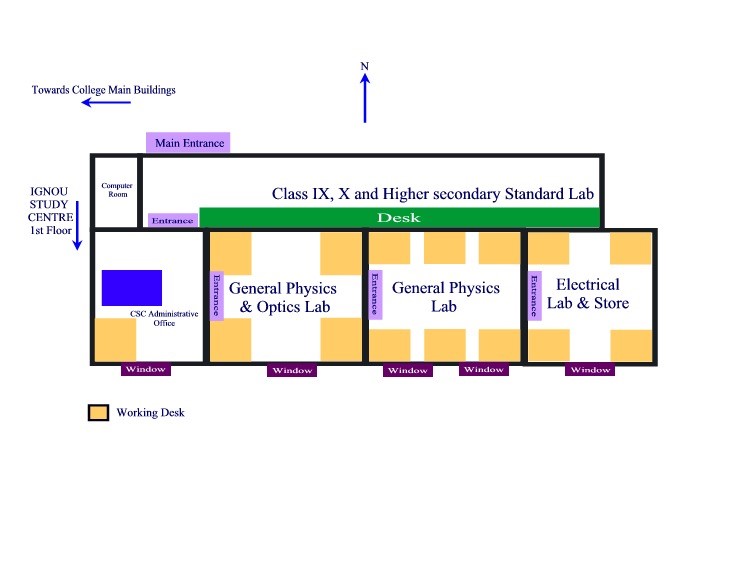| MC-IPT |
IAPT-MIDNAPORE COLLEGE CENTER FOR SCIENTIFIC CULTURE
The Background
To realize the goal of Indian Association of Physics Teachers (IAPT) of inculcating scientific world outlook among the common masses the Executive Council of IAPT, in the late eighties of the last century, took a decision of submitting a proposal to the Govt. of India to establish four Centers for Scientific Culture (CSC) at the four corners of the country. These CSC’s, it was thought, would house the running exhibition of working experiments and people would flock together to these places for a better understanding of nature and natural phenomena, without going to the places of worship. In fact, late Prof. D.P. Khandelwal explained this motivation of IAPT behind setting up of CSC’s, while inaugurating the IAPT-Midnapore College CSC in Feb, 93.Announcement of establishing a CSC out of four contemplated by IAPT, atMidnaporeCollege was made in Oct.92 in its Nagpur conference. Just after three months or so the Midnapore College CSC became operational since its inauguration on Feb.4, 93, with the intensive and extensive participation of the then Physics Honours students of Midnapore college and the Physics teachers of Midnapore college as well as neighboring colleges and schools, eminent Physics teachers of Indian Institute of Technology, Kharagpur also helped in a big way to establish the CSC.
CSC DETAILS
Name and address:
IAPT-MIDNAPORECOLLEGECENTER FOR SCIENTIFIC CULTURE, Paschim Midnapore 721101
Telephone number/s: +91 (03222) 275847
Email: principal.mcm@gmail.com
Date of establishment of the centre:
4th Feb, 1993
Built-up area of the CSC:
CSC lab is spread over two thousand-sq.ft area with an open space of1.5 acre (approx) in front it.
Working hour:
The CSC normally remains open on Saturdays and Sundays (11:00 AM to 5:00 PM) but one can work here on other days also with prior information.
CSC LAYOUT
affiliation
The Centre for Scientific Culture started as an IAPT-MHRD (Govt. of India) project with MidnaporeCollege as the host institute. This situation continued till December 1994, when the project was finally over. In this juncture the Governing Body, MidnaporeCollege in its meeting dated 28.5.94 took the following resolution: “Considered the application of Prof. S.B. Roy and Dr. S.C. Samanta to take IAPT- Midnapore College CSC within the framework of college activities and resolved to accept the proposal. The principal is authorized to place proposals for administrative setup and the financial requirements for running the centre.” So legally the centre is now part of the college.
APPROVAL LATTER FROM IAPT


INAUGURATION OF CSC BY PROFESSOR D. P. KHANDELWAL (MIDDLE), PROF C. L. ROY (LEFT) AND PRINCIPAL M. R. ROY (RIGHT)
CSC Infrastructure
In addition to the routine equipments necessary for lab training to school (secondary as well as higher secondary) students in the physical science and college students in basic physics including project experiments, the CSC has enough advanced equipments for M.Sc students also. Some elementary facilities for testing and designing of experiments and fabrication of equipments are also available here.
Administrative AND FINANCIAL autonomy of CSC
Initially the college received a fund of Rs.1.6 lacks from MHRD, Govt. of India through IAPT. IAPT also provided equipment worth of Rs.1.0lacks. This fund was exhausted by December’94. After that the CSC survived with funds from the college as well as from the DST, Govt.of West Bengal and IAPT National Convention XII fund. At presents IAPT (Central Body) is providing some fund annually for paying remuneration to lab instructor(s) and for contingency expenses.
This IAPT (Central office) fund is meant only for the expenses for the routine programs organized at the center only. For other programs, the centre is providing academic input/resource persons.The expenses are borne out by the collaborating agency. The MidnaporeCollege provides the cost of housing, electricity and water. At present the center provides academic input and resource persons to the following agencies.
- Indian Association of Physics Teachers (RC –15)
- Science Centre, Midnapore
- Egra Organization for Cultivation of Science, Midnapore (East)
- Some schools for organizing laboratory kit making workshops and Science exhibitions
The financial aspects of the programmes are always managed by the relevant collaborating agency and other academic Funding agencies.
Academic and supporting staff
Academic stuff
At the beginning the following teachers were formally entrusted with the different academic activities of the CSC:
- Prof. S.B. Roy (Joint Director, CSC)
- Dr. S. C. Das
- Dr. S. K. Ghorai
- Dr. G. N. Roy
- Sri S. K. Pan
- Dr. S.C. Samanta (Convener, Working Group, CSC)
But informally many teachers along with students within and outside the college were involved in the various activities of the CSC. Notable among them were Prof. Dr. P.K. Chakraborty (Former Reader,of Kharagpur College and ex-principal of the college), Dr. Satrughna Bera, Dr. Gopal Ch. Bera, Sri Madhusudhan Gantait. The role of the students, immediate past and present was most significant in building and running the edifice of structure of the CSC.
At present Dr. Gopal Ch. Bera, Principal of our college is looking after the CSC but whenever necessary services of the other teachers including those from other subjects and other institutions are readily available. Dr. S. C. Samanta, (former General Secretary IAPT and Reader of Physics Dept. and Convener, working group CSC ) is still actively involved in all the programmes organized by this centre. Mr. Anirban Samanta M.Sc. Electronics ) is actively engaged himself in the programmes organized by this centre. As usual the students of the physics department are very active in the CSC programmes, particularly in their final year. Even after graduating from the college they continue their voluntary services. In fact, they provide most necessary human resources for carrying out indoor and outdoor activities of the CSC.
Supporting Staff:
At the initial stage Mr. Sanjit Paul, Mr. Biswanath Das, Mr. Durgapada De provided support for building the center. At present Mr. Kali Kinakar Roul and Mr. Trilochan Manna undertakes the job of instructor cum technical assistant.
Regular Activities And Current ProgramMes
In its regular weekly programmes on Saturdays & Sundays, the school & college students try the CSC experiments as well as undertake the project experiment of their choice. Even students from different colleges do their regular practical (which are within the curriculum ) in this centre.The outcome of the participation of the students of different levels is that the CSC has a large pool of experiments of different levels, in its kits, relevant to the studies of Physics at schools & colleges. With these experiments in its kits, the CSC is capable of helping schools to organize educational science exhibitions and participative demonstrations of science experiments. This store house of experiments helped the CSC provide academic input to various endeavors of IAPT and other NGOs’, involving UG students, both at national and regional level. Over the last eighteen years , the CSC has organized many training and orientation courses involving secondary, plus 2 and college teachers, seminars on issues related to Physics teaching and evaluation and Workshops on experiments involving school and college students. At present, the CSC is trying to work out an elaborate programme of establishing makeshift laboratory-the Folding laboratory, in school classrooms when routine teaching work is suspended. The purpose of this programme is to provide secondary school students an opportunity to try the demonstration experiments relevant to their science study and perform; in details some measurement based experiments. This programme has already been conducted at certain locations, with success. In fact, the only surviving CSC, the IAPT-Midnapore College Centre for Scientific Culture has become the growth centre for IAPT activities in this region.
DESIGN AND TESTING OF NEW EXPERIMENTS
1. School level (up to X th Standard):
The CSC is equipped to help school students to learn science through performing measurement-based experiments. Even it can help school to set up temporary laboratories for the purpose as classroom or can setup permanent lab as a cost affordable by a school situated at a remote poverty stricken area.
2. Higher secondary level:
As an offshoot of the of the nationwide program lunched as an IAPT-MHR&D project “Operation Physics Through Experiment” a kit of experiments relevance to study in HS physics has been developed. All the experiments in the kit including the manual are available for performance at CSC. CSC has supplied about 40 such kit to different HS School in a very low cost.List of experiments that can be performed by this kit is given below.
EXPERIMENT-1: Restoring force on the oscillating body attached to a spiral spring and the potential energy of the system during the oscillation.
EXPERIMENT-2: Energy loss of oscillator due to damping.
EXPERIMENT-3: Spring constant K and the effective mass of the spring in the oscillating system.
EXPERIMENT-4: Centre of gravity (centre of mass) of a rectangular wooden lamina.
EXPERIMENT-5: Rotational equilibrium (using a rectangular lamina).
EXPERIMENT-6: Perpendicular axis theorem for M.I. of a lamina body.
EXPERIMENT-7: Resonating air column in a tube with one end closed.
EXPERIMENT-8: Interference of sound (two sources speakers).
EXPERIMENT-9: Interference of sound: Quinke’s tube.
EXPERIMENT-10: Specific heat of a liquid by cooling.
EXPERIMENT-11: Relation between the resistance of a Thermestor and its temperature.
EXPERIMENT-12: Angular magnification of a simple microscope.
EXPERIMENT-13: Assembling a telescope and determining its angular magnification.
EXPERIMENT-14: To study response of LDR to light.
EXPERIMENT-15: Response of a photodiode/ phototransistor to intensity of light, and V-I characteristics.
EXPERIMENT-16: Use of photodiode/phototransistor to compare light intensities.
EXPERIMENT-17: The ‘loading error’ in voltmeter reading.
EXPERIMENT-18: A regulated power supply.
EXPERIMENT-19: Measuring the capacitance of a capacitor by determining (1) the charge stored on a capacitor (2) energy stored in a capacitor.
EXPERIMENT-20: Charging and discharging of a capacitor. – Role of time constant.
EXPERIMENT-21: Frequency of AC mains supply.
EXPERIMENT-22: Diode as rectifier and its use in determining the peak value of alternating voltage.
EXPERIMENT-23: Determining the effective value of voltage (or current) of an alternating power supply by comparing its power with that of a DC supply.
EXPERIMENT-24: Determining the capacitance of a capacitor and inductance of an inductor by 1. ‘Equal voltages’ method. 2. Vector diagram method (three voltages method).
EXPERIMENT-25: Capacitor as a linear element. Dependency of capacitive reactance on the frequency of AC.
EXPERIMENT-26: Investigating the electric field between two electrodes of various geometries through the potential profiles.
EXPERIMENT-27: Use of transistor as an amplifier and as a switch.
EXPERIMENT-28: Truth tables of basic logic gates.
EXPERIMENT-29: Loss of potential energy of water in a vessel due to leakage.
EXPERIMENT-30: Resonance in pendulums.
EXPERIMENT-31: Series and parallel resonance in L-C-R circuits.
3. UG Level:
CSC is providing academic input to the summer workshops, experiment-based, problem type examinations at UG level, Experiments for Indian National Physics Olympiads. In these endeavors a good number of innovative and open-ended experiments have been developed here. Some manuals have also been prepared at different times. A brief list of such experiments is also given below.
Experiment-1: Dispersion of light through a liquid prism.
Experiment-2: To determine dipole moment of water molecules.
Experiment-3: A simple arrangement for studying elliptically polarized light.
Experiment-4: Determination of h with LED & grating.
Experiment-5: Fraunhofer diffraction by a slit of varying width, double-slit, and grating with LASER.
Experiment-6: Determination of striking & extinction potentials of neon gas.
Experiment-7: Studies with a step-down transformer.
Experiment-8: Experiments with a magnetic levitation set.
Experiment-9: Action of current on current-a dynamic study.
Experiment-10: A determination of Curie temperature of a ferrite rod.
Experiment-11: An AC method of measuring permeability.
Experiment-12: Determination of neutral & inversion points of a thermocouple.
Experiment-13: Resistance thermometry.
Experiment-14: An electrical method of measuring elastic constants.
Experiment-15: Interaction between two coils.
Experiment-16: Flow of water through a capillary.
Experiment-17: A study with an electronically maintained compound pendulum.
Experiment-18: Basic characteristics of solar cell.
Experiment-19: Thermal conductivity of air.
Experiment-20: switched capacitor circuit.
Experiment-21: Sample and hold circuit.
Experiment-22: To measure dielectric constant of different solids.
4. PG Level:
The CSC has equipment like CRO, function generators etc needed for performing advance level experiments in electronics, included in the M.Sc (Physics). In fact some M.Sc students used to visit the CSC for performing experiments and project work suitable to their studies.
Highlights of IAPT-Midnapore College CSC
More than Rs. 25 Lakhs fund received for the outreach and extension activities from various academic funding agencies as cash and Kinds
IAPT-Midnapore College centre for Scientific Culture established in 1993 as public laboratory for activity based science education from Madhyamik to post graduate level. Our department has actively engaged with this centre. In the last five year we have got a large number of projects for activity based science learning.
- Project-1. Learning Science through experiments sponsored by SarrbaSiksha Mission, JilaParishad, PaschimMedinipurRs. 1,80,000/- (2012)
- Project- 2. Lecture Workshop on “Basic and Interdisciplinary Topics in Physics” at Midnapore College, Midnapore from 4-6 February 2013, sponsored by Indian Academy of Science, 114000/-
- Project-3. Workshop in Experimental Physics for 2nd year B. Sc (Physics Hons) Students in January 2014 for four days sponsored by DST, Govt. of West Bengal, Rs. 50,000/-
- Project-4. “Design and development of Physics Experiments” Procurement of instrument of this centre sponsored by S N Bose National Centre for Basic Science Rs. 5,00,000/-
- Project -5. “DESIGNING EXPERIMENTAL PROJECTS IN PHYSICS” with the collaboration of Indian Academy of Science, Bangalore on and from 8th to 21st October 2014) Rs.5,00,000/-
- Project -6. Two-day workshop on experimental physics (new higher secondary syllabus) on 24th and 25th April 2015, Sponsored by DST, West Bengal, Rs. 50,000/-
- Project-7. Two-day workshop on experimental physics on 16 and 17th Dec 2016, Sponsored by DST, West Bengal, Rs. 50,000/-
- Project-8. Ongoing Teachers’ Orientation Workshops “ Active Teaching–Learning Processes” Jointly with TLC, CET,IIT Khargapur under the scheme PMMMNMTT, MHRD, Govt. of India. CET spent Rs. 6,00,000/- till date for 10 workshops.
- More than 60 outreach programme have been performed by this centre with the collaboration of the department of Physics and other departments of the College.
Present Academic and supporting staff
- Gopal Chandra Bera, President of the Centre and Principal, Midnapore College
- S C Samanta, Executive President
- Puspendu Kuila, Joint Coordinator
- Sitangshu Sekhar Pradhan, Joint Coordinator
- M N Goswami, Academic Coordinator
- Tanusri Pal, Physics
- Rajib Pradhan, Physics
- Sukesh Patra, Chemistry
- Dulal Kumar De, Botany
- Biswarup Sarkar, Physiology
- Goutam Ghosh, Zoology
- Krishna Gopal Dhal, Computer Science
- Rajsekhar Bar, Physics
- Kalikinkar Roul, Technical Staff
- Trilochan Manna, Technical Staff
Future Vision
In carrying our CSC programmes we feel that Science education has its weakest links in schools. So we like to make following planning in future.
- To adopt some schools when the CSC activist (he may be college/university student) would help to set up permanent school laboratories, so that the school students can perform measurement-based experiments and organize educational science exhibition.
- To set up temporary labs in classrooms in schools when the schools are not in session so that the school students get a test of science experiments. In this effort also the college/ university student, guided by teachers associated with CSC, may help for running this lab.

